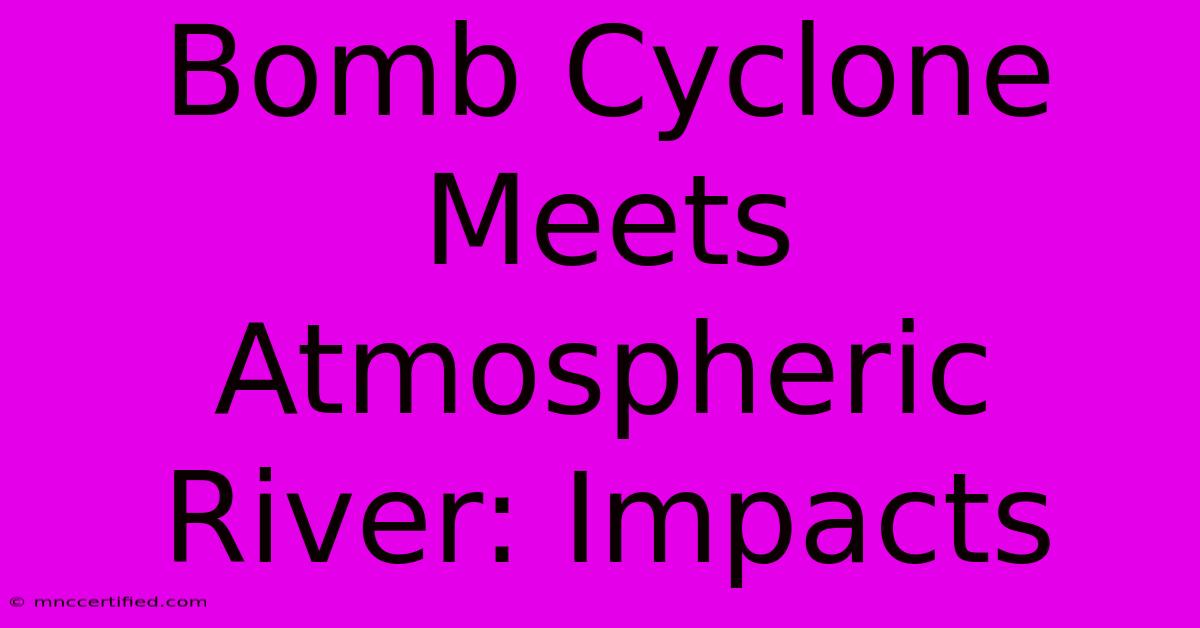Bomb Cyclone Meets Atmospheric River: Impacts

Table of Contents
Bomb Cyclone Meets Atmospheric River: Impacts and Preparedness
The convergence of a bomb cyclone and an atmospheric river is a meteorological event with potentially devastating consequences. Understanding the individual impacts of each phenomenon and their combined effects is crucial for preparedness and mitigation. This article will delve into the science behind these weather events, explore their individual and synergistic impacts, and offer guidance on how to prepare for such extreme weather.
Understanding the Players: Bomb Cyclones and Atmospheric Rivers
Let's first define our key players:
Bomb Cyclones: Rapid Intensification
A bomb cyclone, also known as a bombogenesis, is an extratropical cyclone that intensifies rapidly. This rapid intensification is defined by a drop in central pressure of at least 24 millibars in 24 hours. This rapid pressure drop fuels stronger winds and heavier precipitation. The resulting storm brings severe weather conditions, including:
- High winds: Capable of causing significant damage to property and infrastructure.
- Heavy snowfall: Leading to blizzards, power outages, and transportation disruptions.
- Coastal flooding: Storm surges and high waves can inundate coastal areas.
- Extreme cold: Bomb cyclones often draw in frigid Arctic air, leading to dangerously low temperatures.
Atmospheric Rivers: Rivers in the Sky
Atmospheric rivers (ARs) are long, narrow, and transient corridors or filaments of concentrated water vapor transport in the lower atmosphere. Think of them as rivers in the sky, carrying immense amounts of water vapor from tropical and subtropical regions towards higher latitudes. Their impacts include:
- Heavy rainfall: Leading to flooding, landslides, and mudslides, particularly in mountainous regions.
- High winds: Similar to bomb cyclones, ARs can generate strong winds, exacerbating the impacts of heavy rain.
- Snowmelt: In higher elevations, ARs can trigger rapid snowmelt, further contributing to flooding.
The Synergistic Impact: A Perfect Storm
When a bomb cyclone and an atmospheric river collide, the consequences are amplified dramatically. The bomb cyclone's intense low pressure system acts as a powerful engine, drawing in the vast amounts of moisture from the atmospheric river. This results in:
- Intensified precipitation: The combination leads to exceptionally heavy rainfall and snowfall, far exceeding the impacts of either event alone.
- Enhanced flooding: The sheer volume of water combined with high winds increases the risk of catastrophic flooding and erosion.
- Widespread damage: The combined force of high winds and heavy precipitation leads to widespread damage to infrastructure, including power lines, roads, and buildings.
Case Studies: Real-World Examples
Numerous historical events highlight the devastating potential of this combined weather phenomenon. Analyzing past events provides crucial insights for future preparedness. Researching specific case studies, like those affecting the West Coast of the United States, can offer valuable data on the scale and type of damage to expect.
Preparing for a Bomb Cyclone and Atmospheric River Convergence
Preparing for such a powerful combination of weather events requires a multi-faceted approach:
- Develop an emergency plan: This includes identifying evacuation routes, assembling an emergency kit, and establishing communication strategies with family and friends.
- Monitor weather forecasts: Pay close attention to weather warnings and advisories issued by meteorological agencies.
- Secure your property: Take steps to protect your home and property from wind damage and flooding.
- Stay informed: Follow updates from reliable news sources and government agencies.
- Know your risk: Understanding your vulnerability to flooding, high winds, and power outages is crucial for effective preparedness.
Conclusion: Mitigation and Long-Term Planning
The convergence of a bomb cyclone and an atmospheric river presents a significant threat to communities worldwide. By understanding the science behind these events, learning from past experiences, and developing comprehensive preparedness strategies, we can mitigate the impacts and build more resilient communities capable of withstanding these extreme weather phenomena. Continued research and investment in early warning systems are essential for safeguarding lives and protecting infrastructure from the increasing frequency and intensity of these powerful storms. This includes promoting climate change awareness and adaptation strategies to address the underlying drivers of these extreme weather events.

Thank you for visiting our website wich cover about Bomb Cyclone Meets Atmospheric River: Impacts. We hope the information provided has been useful to you. Feel free to contact us if you have any questions or need further assistance. See you next time and dont miss to bookmark.
Featured Posts
-
De Generes De Rossi Exit Us
Nov 21, 2024
-
Stalker 2 Review A Broken Masterpiece
Nov 21, 2024
-
Penn State Outreach Impact Map
Nov 21, 2024
-
Self Defense Liability Insurance
Nov 21, 2024
-
Crypto Exchanges In South Africa
Nov 21, 2024